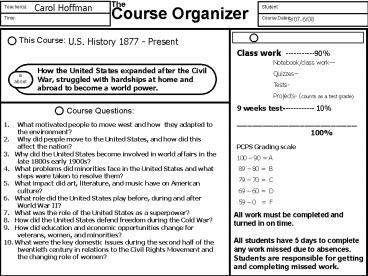Carol Hoffman - PowerPoint PPT Presentation
1 / 2
Title:
Carol Hoffman
Description:
Great Plains. Immigration. Political Machine. Progressive Movement. Electrification ... Settlement of the Great Plains. Immigration and. the growth of cities ... – PowerPoint PPT presentation
Number of Views:41
Avg rating:3.0/5.0
Title: Carol Hoffman
1
Carol Hoffman
9/07-6/08
U.S. History 1877 - Present
Class work -----------90
Notebook/class work Quizzes-- Tests-
Projects- (counts as a test grade) 9 weeks
test------------ 10 _______________________
100
How the United States expanded after the Civil
War, struggled with hardships at home and abroad
to become a world power.
- What motivated people to move west and how they
adapted to the environment? - Why did people move to the United States, and how
did this affect the nation? - 3. Why did the United States become involved in
world affairs in the late 1800s early 1900s? - 4. What problems did minorities face in the
United States and what steps were taken to
resolve them? - 5. What impact did art, literature, and music
have on American culture? - 6. What role did the United States play before,
during and after World War II? - 7. What was the role of the United States as a
superpower? - 8. How did the United States defend freedom
during the Cold War? - 9. How did education and economic opportunities
change for veterans, women, and minorities? - 10. What were the key domestic issues during the
second half of the twentieth century in relations
to the Civil Rights Movement and the changing
role of women?
PCPS Grading scale 100 90 A 89 80 B 79
70 C 69 60 D 59 0 F
All work must be completed and turned in on
time. All students have 5 days to complete any
work missed due to absences. Students are
responsible for getting and completing missed
work.
2
U.S. History 1877 - Present
Interactive note book Quizzes Tests Projects Homew
ork Nine weeks tests
- Course organizer
- Interactive note taking
- testing assessment
- Cooperative Learning
- sequencing
- plays
- Respect self
- Respect others
- Respect property
- Do your Best
- Unit organizer
- SIM routines
- agenda
- think pair share
- illustrations
Westward expansion Great Plains Immigration Politi
cal Machine Progressive Movement
Electrification segregation Equality World
Power Fascism
Superpower Harlem Renaissance Abroad Technological
advances
Settlement of the Great Plains
Civil rights, Women's rights and new technology
Post WWII prosperity and the Cold War
Immigration and the growth of cities
Early 20th Century innovations and problems
Late 19th Century through WWI
World War II


















![???, ?????20?,???????????????????, ???? (J.D.) ????Pepperdine???LL.M.??, ??????????????????????????????????? (ACR)??????????????????????????????[????]??,????????Peacemaker Ministries????????????????????????????????????????,????????????????????? PowerPoint PPT Presentation](https://s3.amazonaws.com/images.powershow.com/A1260045940VkAPy.th0.jpg?_=20140217067)












